
Phalangeriformes is a paraphyletic suborder of about 70 species of small to medium-sized arboreal marsupials native to Australia, New Guinea, and Sulawesi. The species are commonly known as possums, gliders, and cuscus. The common name "possum" for various Phalangeriformes species derives from the creatures' resemblance to the opossums of the Americas. However, although opossums are also marsupials, Australasian possums are more closely related to other Australasian marsupials such as kangaroos.

The peregrine falcon, also known as the peregrine, and historically as the duck hawk in North America, is a widespread bird of prey (raptor) in the family Falconidae. A large, crow-sized falcon, it has a blue-grey back, barred white underparts, and a black head. The peregrine is renowned for its speed, reaching over 320 km/h (200 mph) during its characteristic hunting stoop, making it the fastest bird in the world, as well as the fastest member of the animal kingdom. According to a National Geographic TV program, the highest measured speed of a peregrine falcon is 389 km/h (242 mph). As is typical for bird-eating raptors, peregrine falcons are sexually dimorphic, with females being considerably larger than males.
Peregrine, Latin Peregrinus, is a name originally meaning "one from abroad", that is, a foreigner, traveller, or pilgrim. It may refer to:

The Barbary falcon is a medium-sized falcon about the size of a crow. This bird of prey is mainly resident. It ranges from the Canary Islands eastwards across some parts of North Africa, the Middle East and Central Asia

Mimulus is a plant genus in the family Phrymaceae, which was traditionally placed in family Scrophulariaceae. The genus now contains only seven species, two native to eastern North America and the other five native to Asia, Australia, Africa, or Madagascar. In the past, about 150 species were placed in this genus, most of which have since been assigned to other genera, the majority to genus Erythranthe.
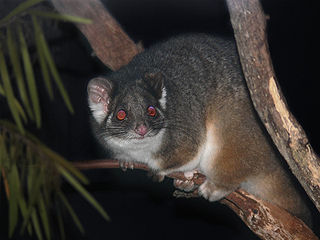
The common ringtail possum is an Australian marsupial. It lives in a variety of habitats and eats a variety of leaves of both native and introduced plants, as well as flowers, fruits and sap. This possum also consumes a special type of faeces that is produced during the daytime when it is resting in a nest. This behaviour is called caecotrophy and is similar to that seen in rabbits.
In the geologic timescale, the Valanginian is an age or stage of the Early or Lower Cretaceous. It spans between 139.8 ± 3.0 Ma and 132.9 ± 2.0 Ma. The Valanginian stage succeeds the Berriasian stage of the Lower Cretaceous and precedes the Hauterivian stage of the Lower Cretaceous.

Pseudocheiridae is a family of arboreal marsupials containing 17 extant species of ringtailed possums and close relatives. They are found in forested areas and shrublands throughout Australia and New Guinea.

Pseudocheirus is a genus of ringtail possums. It includes a single living species, the common ringtail possum of Australia, as well as the fossil Pseudocheirus marshalli from the Pliocene of Victoria.
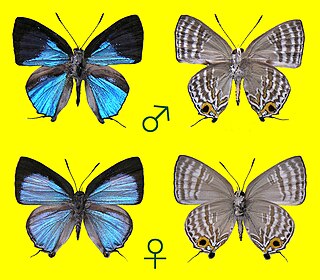
Sinthusa is a genus of lycaenid butterflies, the sparks. They are small species with the male genitalia and secondary sexual characters of Virachola, but less robust and weaker in flight. The males are easily recognized, with the forewings oily indigo blue changing to shining blue in a side light and hindwings shining violet blue in all lights. The species of this genus are found in the Indomalayan realm. The genus was erected by Frederic Moore in 1884.

Indolestes is a genus of damselflies in the family Lestidae. Species of Indolestes can be medium-sized, dull coloured dragonflies. They are found from India through Asia, Australia and the Pacific.

Erigeron peregrinus is a North American species of flowering plants in the daisy family known by the common name wandering fleabane.
Foulonia is a genus of trilobites in the order Phacopida, that existed during the lower Ordovician in what is now France. It was described by Pribyl and Vanek in 1985, and the type species is Foulonia peregrinus, which was originally described under the genus Ceraurinella by Dean in 1966. The type locality was on Montagne Noire.
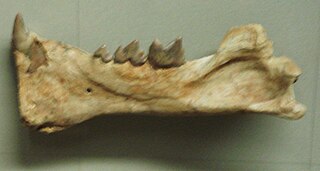
Prosansanosmilus is an extinct genus of mammalian carnivores of the suborder Feliformia, family Barbourofelidae, which lived in Europe during the Miocene epoch, existing for approximately 0.9 million years .

Petauroidea is a superfamily of marsupials from Australia and New Guinea. It is part of the suborder Phalangeriformes within the order Diprotodontia, which also includes, among others, wombats, kangaroos, cuscuses. The superfamily Phalangeroidea, including cuscuses and brushtail possums and pygmy possums, is the immediate sister group of the Petauroidea.
Pinus peregrinus is an extinct species of pine in the family Pinaceae known from Clarkforkian age Paleocene fossils found in western North Dakota, USA.
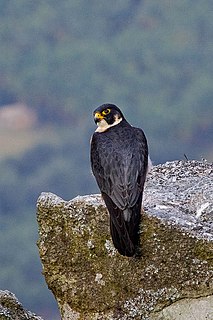
The shaheen falcon is a non-migratory subspecies of the peregrine falcon found mainly in the Indian subcontinent. It has also been described as a migratory subspecies. Other common names for the subspecies include the black shaheen and Indian peregrine falcon. The word shaheen in these names may also be spelled as shahin. This species was termed as the black shaheen by falconers to separate it from the true shaheen of Persian literature. Scholars of Persian and the Russian ornithologist Georgi Petrovich Dementiev have noted that the name shaheen in Persian literature actually referred to Falco peregrinus babylonicus.
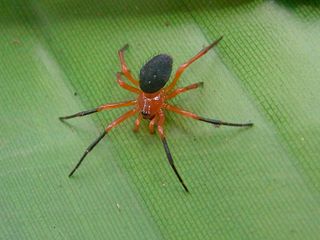
Nicodamus is a genus of small spiders known from Australia. They are often referred to as the red and black spiders. As of 2017 its two species include Nicodamus peregrinus and Nicodamus mainae.
Prosansanosmilus peregrinus belongs to the genus Prosansanosmilus in the extinct family Barbourofelidae. It died out in the Miocene epoch.

Curio is a genus of flowering plant in the family Asteraceae. Plants in the genus are evergreen succulents with long, striated leaves and discoid flower heads lacking ray florets.














